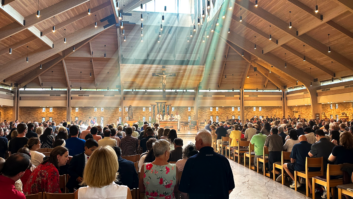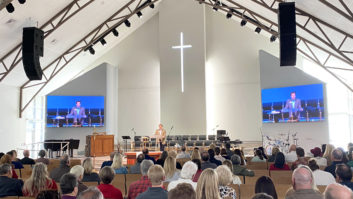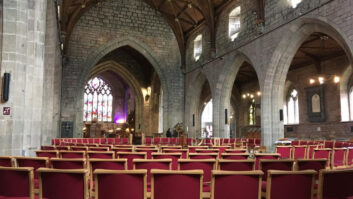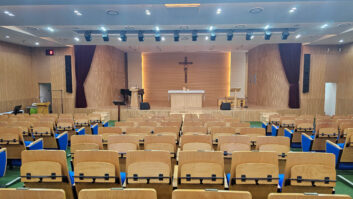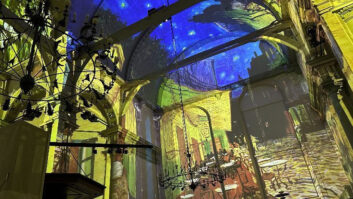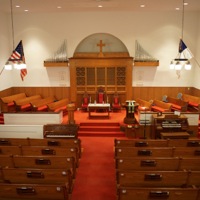
The rosy health of the houses of worship (HoW) market has been a recurring theme of Installation features for many years now. With church attendance remaining fairly high and consistent in core markets such as the US (43% of people visited weekly or almost weekly in 2010, according to Gallup), and evincing some signs of a resurgence in countries such as the UK where it had previously been spiralling downwards for decades, this tendency is unlikely to be challenged any time soon.
Moreover, on a technological level at least, it’s a sector whose scope only increases. Logically enough given the frequently challenging architectural and acoustic nature of these spaces, the focus of installation activity has often been on improving intelligibility and, for more evangelically oriented churches, sensitively reinforcing live band-based worship. But with many churches increasingly active with regard to reaching congregants new and old remotely, capturing audio and video for distribution online or even to conventional broadcast television and radio is now more of a priority.
“An increasing number of churches want to take their services and upload them to the web to be able to reach out to those people who can’t attend the sessions. They’re really eager to use technology to get the message out there,” says Stuart Ashton, director EMEA for switching, converter and processing specialist Blackmagic Design, whose broadcast/post core has steadily grown to include more ‘traditional’ areas of install, such as HoWs, over the past five years.
“In today’s world, not everyone can get to church on Sunday morning, so it makes sense to put services online,” says Derek Clare, partner at UK AV installer and supplier New Day, for whom church-related projects constitute the vast majority of turnover. “Many churches have been recording sound and issuing CDs [for years], but now some are recording to Flash drives and are beginning to think about video, too. They know it’s a very powerful medium to get into.”
If these are developments unlikely to warm the heart of Richard Dawkins, they nonetheless confirm that for manufacturers and integrators HoW continues to be a valuable revenue-generator. And although congregant donations have inevitably come under pressure during the downturn, this remains a sector more worthy than most of the epithet ‘recession-proof’.
In a trend that follows on from a precedent set by larger US worship spaces, HoWs are becoming more cognisant of the opportunities for an ‘afterlife’ for their services. In some cases, this may involve the capture of audio-only for distribution on CD, online or conventional radio broadcast, but with set-ups that can be as sophisticated as a middle-ranking theatre or concert hall.
“Multitrack recording for subsequent broadcast is now a very common requirement for HoW installations,” says Leon Phillips, product manager at Allen & Heath, for whom the GLD and iLive digital mixing systems are selling “very strongly” into medium and large HoWs, respectively.
In those cases where customers are using digital desks, says Phillips, they “generally opt for Dante or MADI for recording”. Although the migration to digital continues apace, plenty of facilities are still working off analogue mixers but wishing to document services in high quality – a requirement acknowledged by Allen & Heath with its ICE-16 recorder, which allows the user to capture multitrack audio from an analogue desk direct to a USB key.
Many HoWs are looking for more flexible distribution of audio to ease both internal and external usage. Stuart McKay, digital console and installation specialist at Audio-Technica UK – which serves as Allen & Heath’s exclusive distributor in the UK – says that it’s “fantastic for us as it means that [in addition] to HoWs looking to improve the quality of the equipment they use, they are also interested in distributing multi-tracked audio around separate consoles – FOH, monitors and broadcast – giving independent mixes for each audience.”
As a pioneer behind precise directivity sound reinforcement, Duran Audio has been well placed to track the development of audio in the worship space. Max Lindsay-Johnson, who leads the company’s international sales and marketing effort, indicates a growing demand for digital network interfaces as part of a more integrated approach to audio. “Some HoWs are still installing analogue networks, but we do have some larger ongoing projects that involve [optical digital fibre networking technology] Optocore,” he says, pointing to the 2012 launch of an Optocore DM1-TP digital audio interface for Duran Audio’s Intellivox range of AXYS products that enables them to be incorporated into synchronous, low-latency, redundant Optocore and SANE networks.
Video stars?
Although a sizeable number of churches have yet to invest in video, many are now exploring the potential of picture for congregants both inside and outside the worship space. Once again – and whatever the project scope – it’s all about getting the message out to the largest possible number of people.
“Using streaming technology, remote facilities can be connected to a central worship facility for live simulcast services, while in multicultural societies public broadcast and internet videos make it possible for immigrants to view and hear services in their native languages,” says Julia Lee, director of sales and marketing at Community Professional Loudspeakers, for whom HoW continues to represent a “major vertical market” in North America, Europe and Asia.
For those establishments seeking to capture video for internal and external usage, a multi-camera set-up involving three to six cameras and HDMI technology is by no means unfamiliar. “Predominantly,” says Ashton, outlining a typical workflow, “we are talking about HDMI cameras being converted to SDI, with SDI being routed around the facilities and then conversion to the production switchers that deliver the feeds. In some cases, this might be to screens located around the church. On other occasions, where maybe the HoW isn’t using screens for its congregation, it might be a question of taking the master mix, dropping it to tape or SSD, and then moving it on to post for editing or simply putting online.”
Although such high-end deployments tend to be limited to middle-to-large-scale facilities, Ashton observes a sustained increase in demand from HoWs across Europe, the US and, increasingly, the Middle East for Blackmagic Design products such as the HyperDeck Shuttle, billed as the world’s smallest solid-state disk 4:2:2 video recorder with SDI and HDMI.
Derek Clare from New Day – which is a frequent customer of Blackmagic Design, among others – confirms the extent to which HD is now exerting an influence on the HoW market, recalling how “two years ago we went from fitting VGA systems to HDMI virtually overnight”.
Monitoring control
Of course, in tandem with the new requirements, many HoWs are still battling to combat the old problems of high reverberation times and the need for low visual impact. Lee confirms the enduring nature of these issues, noting that “improved intelligibility is important in all HoWs. And, since many HoWs include important religious symbols and architecture, AV systems must be visually unobtrusive while delivering the message and supporting the worship service.”
With a burgeoning number of Christian HoWs incorporating live band ‘praise music’, the impetus to provide effective personal monitoring solutions is also an abiding theme of church audio upgrades. Indeed, it even informed the development of Allen & Heath’s ME personal mixing system, which was launched at Winter NAMM in January and allows musicians to control their own monitor mixes.
“One strong theme that came out of our on-the-ground research with HoWs was the need for more powerful personal monitoring solutions, which led directly to the development of the ME personal mixing system,” says Phillips. “Even as HoW systems become more sophisticated, installers still emphasise the need for ease of use. Our R&D team goes to great lengths to ensure that features are logically and clearly laid out, and that essential functions can be accessed in the heat of the moment without the need to delve into complex menus.”
Trial run for 4K?
With the desire to disseminate services more widely driving technological investment, it’s no surprise to discover that tablet and mobile applications are likely to be another growth area. Such devices, asserts Lee, “will undoubtedly introduce the facility for two-way AV streaming, thereby giving remote worshippers the opportunity for active participation in events”.
Ashton, meanwhile, believes that there is some potential for HoWs to serve as a dry-run for the fast-emerging 4K ultra-HD television technology. “It’s going to be very interesting to see how the 4K thing grows this year,” he posits, “and with the restrictions that the broadcasters are facing I think it’s possible that 4K could grow more quickly among HoWs with larger budgets or greater aspirations than in [more conventional areas of broadcast].”
Such, it seems, is the fast-changing face of 21st century worship. With AV increasingly highly specified within the worship space, look out for an ever-expanding focus on the technology that helps churches take their services to the people – wherever they may be.
www.allen-heath.com
www.atlanticproaudio.com
eu.audio-technica.com
www.blackmagicdesign.com
www.communitypro.com
www.digico.biz
www.duran-audio.com
www.electrovoice.com
